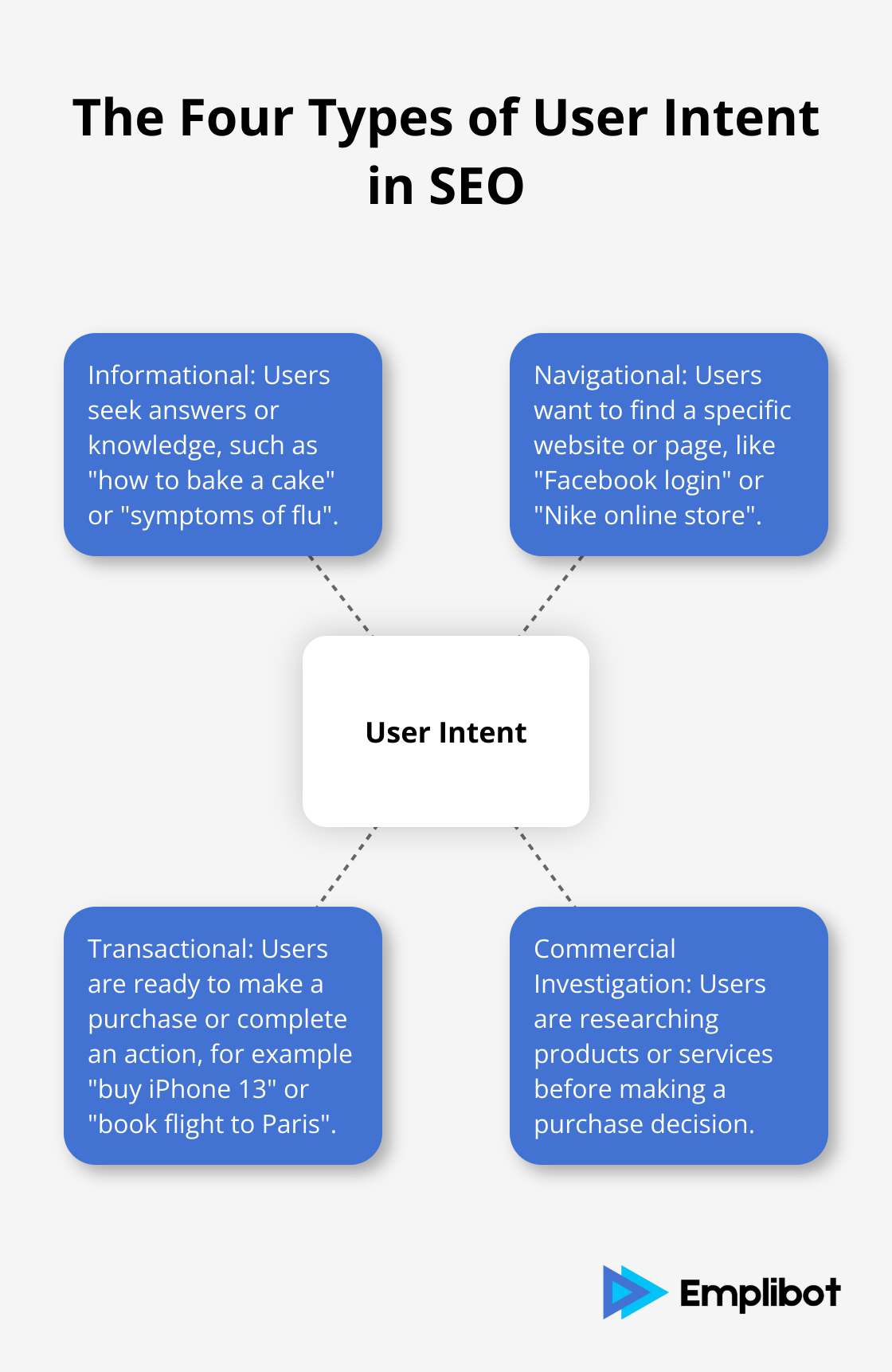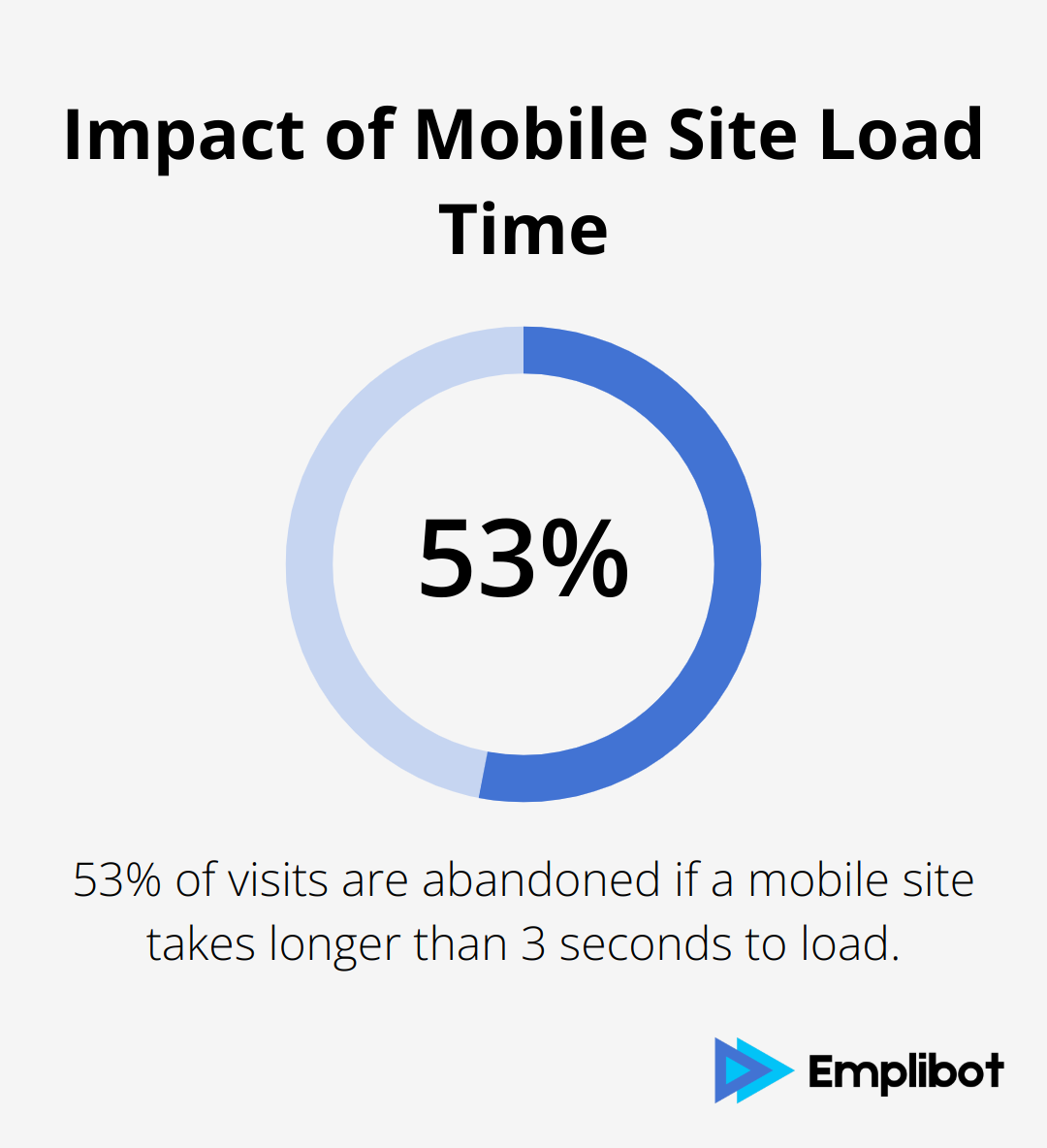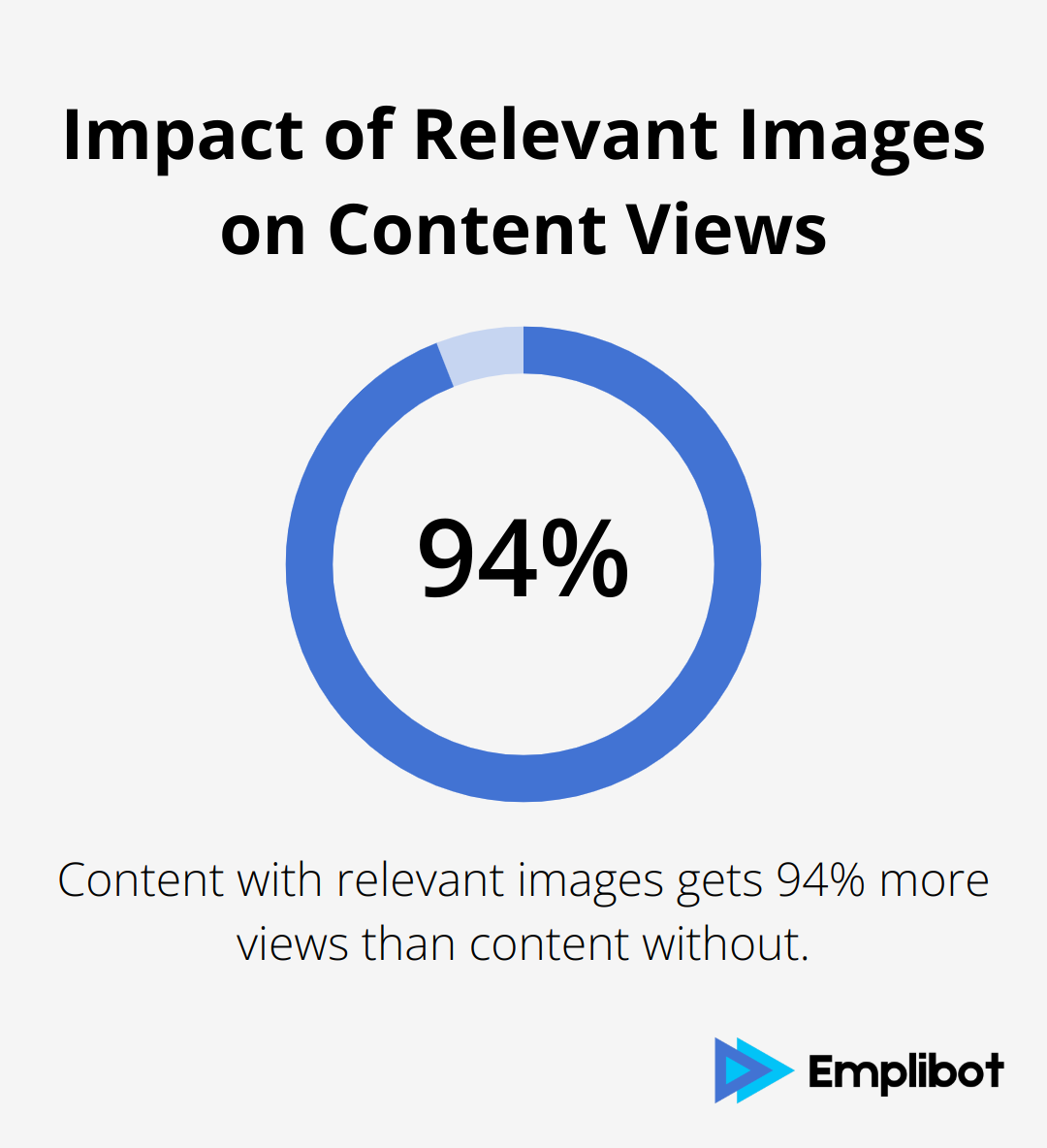At Emplibot, we’re fascinated by the intersection of psychology and search engine optimization.
The psychology of SEO goes beyond technical aspects, delving into how human behavior influences search patterns and content engagement.
Understanding these psychological principles can dramatically improve your SEO strategy, leading to better rankings and more meaningful user interactions.
In this post, we’ll explore key psychological factors that shape SEO success and how you can leverage them for your website.
What Drives User Intent in SEO?
User intent forms the foundation of effective SEO. Aligning content with user intent can significantly boost rankings and engagement.
The Four Types of User Intent
User intent falls into four main categories:

- Informational: Users seek answers or knowledge (e.g., “how to bake a cake” or “symptoms of flu”).
- Navigational: Users want to find a specific website or page (e.g., “Facebook login” or “Nike online store”).
- Transactional: Users are ready to make a purchase or complete an action (e.g., “buy iPhone 13” or “book flight to Paris”).
- Commercial investigation: Users are researching products or services before making a purchase decision.
How Search Engines Decode User Intent
Search engines have become highly sophisticated in interpreting user intent. They analyze factors such as:
- Query phrasing
- Search history
- Location
- Device type
- Time of day
For example, a search for “pizza” at 7 PM on a mobile device likely indicates a desire to order food, not read about pizza history.
Aligning Content with User Intent
To boost your SEO, your content must match user intent. Here’s how:
- Use intent-specific keywords: For informational content, include words like “guide,” “how-to,” or “what is.” For transactional, use “buy,” “discount,” or “deals.”
- Structure content appropriately: Make informational content comprehensive and well-organized. Design transactional pages with clear calls-to-action and product information.
- Optimize meta descriptions: Craft these 160-character snippets to clearly convey your content’s relevance to the user’s intent.
- Analyze search results: Examine what currently ranks for your target keywords. This provides insight into the dominant user intent for those queries.
- Use schema markup: This structured data helps search engines understand your content’s purpose, improving its chances of matching user intent.
User intent isn’t static. It evolves with trends, seasons, and events. Regular updates to your content strategy ensure you stay aligned with your audience’s changing needs and search behaviors.
As we move forward, it’s clear that understanding user intent is just the first step. The next crucial aspect of SEO psychology involves optimizing the user experience itself. Let’s explore how website speed, design, and content organization play pivotal roles in keeping users engaged and satisfied.
How User Experience Shapes SEO Success
Speed: The Silent SEO Powerhouse
Website speed significantly impacts SEO performance. 53% of visits are abandoned if a mobile site takes longer than 3 seconds to load. To enhance your site speed:

- Optimize images (compress and resize without quality loss)
- Minimize HTTP requests (reduce page elements)
- Use browser caching (store static files locally)
- Implement a Content Delivery Network (distribute content globally)
Google PageSpeed Insights helps identify and resolve speed issues.
Mobile-First: The New SEO Standard
Mobile devices now account for over 50% of global web traffic, making mobile optimization essential. Google uses the mobile version of a site’s content for indexing and ranking. To optimize for mobile:
- Use responsive design (adapt to various screen sizes)
- Implement accelerated mobile pages (create lightweight versions)
- Optimize touch elements (make buttons easily tappable)
Navigation: The User’s Roadmap
Clear navigation reduces bounce rates and increases time on site, both positive SEO signals. Improve your site’s navigation by:
- Using a logical site structure (organize content into clear categories)
- Implementing breadcrumbs (help users understand their site location)
- Creating a sitemap (submit XML sitemap for better indexing)
Content Readability: Engaging Users, Pleasing Algorithms
Readable content keeps users engaged, potentially increasing dwell time and positively impacting SEO. Enhance readability by:
- Using short paragraphs and sentences (break up text for easier scanning)
- Incorporating subheadings (use H2 and H3 tags to structure content)
- Utilizing bullet points and numbered lists (present information concisely)
- Choosing readable fonts (opt for clean, easy-to-read typefaces)
The Flesch-Kincaid readability test helps assess and improve content readability.
These UX elements not only please human visitors but also send strong signals to search engines about your site’s quality and value. As we move forward, we’ll explore how emotional triggers in SEO content can further enhance user engagement and search performance.
How Emotions Boost Your SEO
Emotions play a pivotal role in SEO success. They influence user behavior, engagement, and ultimately, search rankings. Let’s explore how to harness emotional triggers in your SEO content for maximum impact.
The Power of Emotional Headlines
Headlines are your first chance to grab attention. A study by BuzzSumo analyzed 100 million headlines and found that those evoking curiosity, awe, or amusement performed best. To craft emotionally compelling headlines:
- Use numbers: “7 Shocking SEO Tricks That Doubled Our Traffic”
- Ask questions: “Are You Making These Fatal SEO Mistakes?”
- Create urgency: “SEO Secrets You Need to Know Before Your Competitors Do”
Emotional Language That Converts
The words you choose can significantly impact user engagement. A study by CoSchedule found that headlines with emotional words received 22% more shares. Some powerful emotional words include:
- Amazing
- Secret
- Insider
- Proven
- Exclusive
Use these strategically in your content, meta descriptions, and even URLs to boost click-through rates.
Storytelling: The SEO Secret Weapon
Storytelling isn’t just for fiction writers. It’s a powerful SEO tool. According to OneSpot, 92% of consumers want brands to make ads feel like stories. Incorporate storytelling by:
- Using customer testimonials as mini-stories
- Sharing your brand’s journey and challenges
- Creating case studies that follow a narrative arc
This approach not only engages readers but also increases time on page (a key SEO metric).
Visual Content: The Emotional Catalyst
Images and videos aren’t just eye candy. They’re emotional triggers that can significantly boost SEO performance. According to HubSpot, content with relevant images gets 94% more views than content without. To leverage visuals effectively:

- Use high-quality, relevant images
- Create infographics to simplify complex data
- Incorporate videos to increase dwell time
Optimize your visual content with descriptive file names and alt text for SEO benefits.
Emotions transform good SEO into great SEO. Incorporating emotional triggers throughout your content optimizes not just for search engines – but for human connection. Cognitive biases play a significant role in shaping decisions and perceptions unconsciously in online user behavior. By utilizing sentiment analysis, you can gauge user emotions and satisfaction, allowing for immediate improvements to your content strategy and SEO performance.
Final Thoughts
The psychology of SEO shapes user interactions with search results and websites. Understanding these psychological principles allows us to create more effective SEO strategies that resonate with both search engines and human users. User intent, experience, and emotional triggers all play critical roles in SEO success, blurring the lines between technical optimization and user psychology.
As search engines advance in interpreting user behavior, SEO strategies must evolve to focus on creating valuable, engaging content that meets users’ needs. The future of SEO lies in balancing technology and psychology to connect with people, not just chase algorithms. This approach reaches the right people with the right message at the right time.
We at Emplibot strive to stay at the forefront of this evolution. Our AI SEO solution automates content creation, producing high-quality, engaging content optimized for both search engines and human readers. The psychology of SEO will continue to play a significant role in shaping effective digital marketing strategies.

